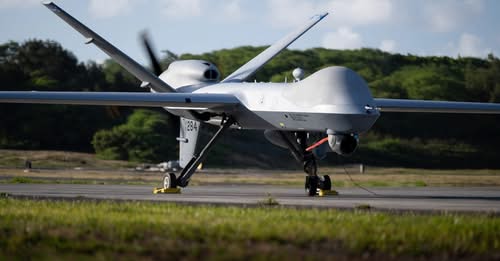Three U.S. MQ-9 Reaper Drones Shot Down by Houthi Militants in Yemen, Marking Escalation in Ongoing Tensions
In a significant escalation of hostilities in the Middle East, Houthi militants in Yemen have successfully shot down three U.S. Air Force MQ-9 Reaper drones over the past week, according to a U.S. official speaking on condition of anonymity. This brings the total number of American drones downed by the Houthis to six since March 15, the date the Trump administration initiated a renewed and sustained air campaign against the Iranian-backed militant group.
The MQ-9 Reaper drones—advanced unmanned aerial vehicles (UAVs) equipped for both surveillance and strike missions—have been central to U.S. intelligence, reconnaissance, and targeted operations in the region. Each Reaper drone costs approximately $30 million and can stay airborne for over 24 hours, providing real-time surveillance and precision strike capabilities. Their loss not only marks a tactical setback but also signals the increasing effectiveness and boldness of Houthi military capabilities.
Strategic and Tactical Implications
The downing of three Reaper drones in a single week represents a significant operational blow for U.S. forces operating in the region and raises questions about the vulnerability of high-tech American assets in contested airspaces. While the specific tactics used by the Houthis to bring down the drones have not been officially disclosed, previous incidents have involved surface-to-air missile systems—likely supplied or enhanced by Iranian technology and support.
This trend suggests a troubling evolution in Houthi air defense capabilities. Their ability to engage and destroy advanced UAVs such as the MQ-9 indicates not only an upgrade in their arsenal but also a growing confidence in directly confronting U.S. military presence in Yemen and the surrounding Red Sea corridor.
Background: A Resurgent Air Campaign
On March 15, the Trump administration launched a renewed air campaign against Houthi positions in response to the group’s increasing attacks on international shipping lanes in the Red Sea and missile launches into neighboring Saudi Arabia and the United Arab Emirates. The strikes have primarily targeted weapons depots, launch sites, command and control centers, and suspected Iranian advisors embedded with Houthi units.
Despite these efforts, the Houthis have remained resilient and adaptive. Analysts believe that the group has strategically leveraged its asymmetric warfare tactics and propaganda to bolster support among local populations while continuing to pose a real threat to international military and commercial operations.
U.S. Military Response and Strategic Calculations
The U.S. Department of Defense has acknowledged the losses but has refrained from offering detailed commentary on the operational impact or the exact locations of the incidents, citing security concerns. Pentagon officials have, however, reiterated the U.S. commitment to safeguarding freedom of navigation in the region and maintaining pressure on militant groups that threaten stability.
In response to the escalating drone losses, there are growing discussions within defense circles about enhancing drone survivability, reassessing air patrol strategies, and potentially increasing the deployment of manned aircraft or other assets less vulnerable to surface-to-air threats.
Broader Geopolitical Implications
The downing of these drones underscores the wider geopolitical contest in Yemen, where the conflict is no longer a mere civil war but a proxy battlefield for regional and international powers. The involvement of Iran through the Houthis, and the U.S. through its support of the internationally recognized Yemeni government and its own military presence, has turned the country into a flashpoint in U.S.-Iran tensions.
The incident also comes at a time when the U.S. is reassessing its military commitments in the Middle East and attempting to recalibrate its global military posture. With public and political fatigue over endless foreign engagements, the Biden administration—though not directly responsible for the renewed campaign—faces pressure over inherited military strategies that continue to incur financial costs and geopolitical risks.
Future Outlook
As the Houthis grow more assertive and technologically capable, and as U.S. operations continue in the region, further engagements are likely. The downing of six drones in just over a month signals a dangerous trend that could lead to broader military confrontations or provoke direct retaliation strikes aimed at degrading the Houthis’ missile and air defense infrastructure.
The Biden administration will need to navigate these developments carefully, balancing the imperative of protecting U.S. assets and interests with the broader objective of avoiding a prolonged and deepening military quagmire in Yemen.
For now, the skies over Yemen remain a dangerous domain, one in which the most advanced aerial systems can be brought down—and where each downed drone is not just a loss of machinery, but a symbol of the ongoing volatility and complexity of modern conflict.

Leave a Reply